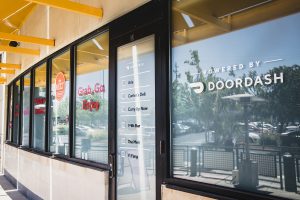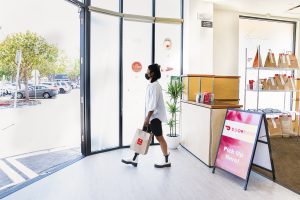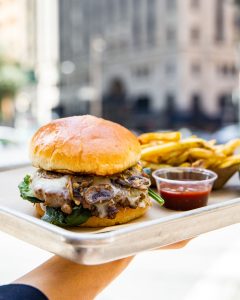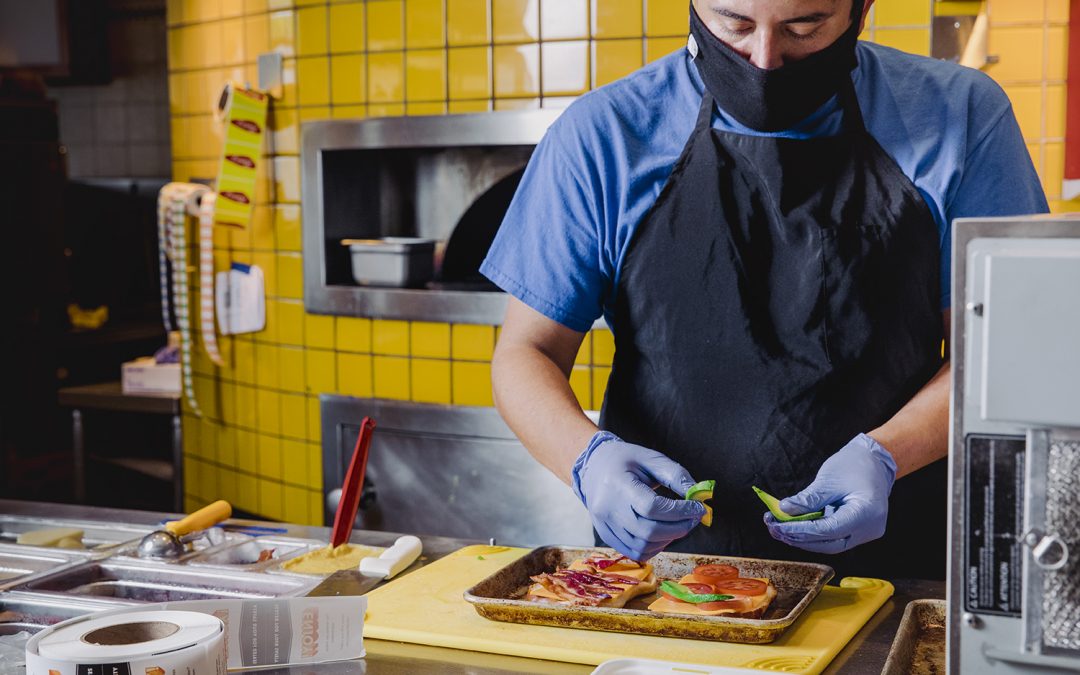Under the new DoorDash Kitchens Full Service program, restaurants can hand over the keys to their brands to the delivery platform’s new army of chefs. We asked one of the first clients in its San Jose facility what got them to sign on the dotted line, and how it’s going so far.
For a quick recap of our story on DoorDash Kitchens Full Service, this new model allows restaurants to license their brands and outsource everything from hiring staff, cooking meals and sourcing ingredients through two of its ghost kitchen facilities in San Jose and Redwood City, California. The largest U.S. delivery provider says this new format gives restaurants the ability to expand without the operational and economic stresses of opening a new brick-and-mortar location—and it’s certainly a new spin on ghost kitchens, which have primarily favored franchised and enterprise restaurants.
The Melt, a San Francisco-based fast-casual brand known for grilled cheese sandwiches, burgers and salads, was one of the first restaurants that signed up for the new Full Service program out of DoorDash’s ghost kitchen in San Jose—an hour south of its home turf.
 Sean Reiter, The Melt’s director of delivery revenue, said the independent restaurant with six locations was initially reluctant about giving up so much control, but said his previous experience at other restaurant brands showed him that it’s more important to set brand partners up for success, rather than stewing over the technical details of ownership. He likened the DoorDash arrangement to other non-traditional partnerships, like those in airports or sports stadiums.
Sean Reiter, The Melt’s director of delivery revenue, said the independent restaurant with six locations was initially reluctant about giving up so much control, but said his previous experience at other restaurant brands showed him that it’s more important to set brand partners up for success, rather than stewing over the technical details of ownership. He likened the DoorDash arrangement to other non-traditional partnerships, like those in airports or sports stadiums.
“I think control is a huge illusion,” he said. “It’s about influence and setting people up for success, and the fact is, once you get beyond even a couple of restaurants, you’ve really lost control … when you really are a control freak as our industry is, your first inclination is to look for any sort of failure to deliver 100 percent and say, ‘There you go,’ but show me a restaurant that operates at 100 percent, show me a restaurant that’s only gotten 5-star Yelp reviews only. Things happen.”
Expounding on his point, Reiter said the idea of perfection in operations or guest satisfaction is illusory and depends on perspective. The leadership team at The Melt asked countless questions of the DoorDash team, and was generally satisfied with their answers and operational competency. In the end, they found this hands-off solution to be a good opportunity to build brand awareness in a new geographic area.
“We didn’t have any sites in our pipeline for the San Jose area at that moment, so it was a very beneficial opportunity for us to expand the brand, to test out the market, see what the demand is, test a partnership and see what happened,” he said. “The big thing that control freaks will see as a negative but we see as a positive is like, essentially, all we have to do is support [DoorDash] doing the best you can.”
Compared to shelling out a minimum of $600,000 to spin up a new brick-and-mortar location The Melt would own and operate, Reiter said this is much less financially involved, shifting that risk onto DoorDash. Whatever contribution they receive back in the form of a royalty from DoorDash is “all gravy.”
“In my career, I’ve seen the power of market saturation, so what this really enables us to do is not only test tout customer interest in San Jose, but it also says to us, OK you’ve got one in San Jose, now we can look toward other areas where we can potentially achieve market saturation without having to go out with capital investments in each of those locations,” he added.
Definitely not a restaurant
Ruth Isenstadt is the director of DoorDash Kitchens, and was previously the head of the company’s IPO push. During the beginnings of the Full Service program, her team is focused on determining how this new business model would work for the company’s merchant partners, as well as for delivery customers, and DoorDash’s employees within its two ghost kitchen facilities before looking toward any future expansion.
 This on-the-job research means paying close attention to Dasher feedback, customer reviews, and learning the ins and outs of multi-brand restaurant operations, which is admittedly a new undertaking for the delivery provider.
This on-the-job research means paying close attention to Dasher feedback, customer reviews, and learning the ins and outs of multi-brand restaurant operations, which is admittedly a new undertaking for the delivery provider.
Isenstadt and company aren’t flying blind, however, as the team hired a staff with culinary and operational expertise, including a development chef who hails from Gordon Ramsay and chefs who have experience working for smaller restaurant groups and large chains.
Whether it’s dealing with the labor crisis, which is especially acute in the Bay Area, or more immediate operational challenges like setting up the most efficient kitchen layout and workflows, early experience is yielding incredibly important lessons from the get-go.
“There’s certainly a lot of things about this business that are newer to DoorDash or not as similar to our core business,” she said. “One of the things that’s been really exciting about operating [these sites] has been really building a lot of empathy and understanding for our restaurant partners in what they experience, both in running their operation, but also in interfacing with our own products—so we often have visits for our own product teams on site to see how our tablets are working or how the Dashers are arriving. We’ve had a lot of learnings that feed into benefits for all of our merchants across the platform, not just the merchants in this service.”
With the delivery provider now shouldering the cost of real estate, purchasing ingredients, hiring kitchen staff and entering into revenue-sharing agreements with restaurants, the Full Service model is a new frontier—and Isenstadt said her primary focus is meeting the expectations of those restaurant partners trusting their brand reputations with DoorDash.
“What will make merchants happy with this service is if we can deliver consistent quality, execute their menu at the same level that they execute it in their restaurants and uphold their brands’ integrity,” she said. “We’ve put a lot of focus into making sure that we have rigorous training techniques and we’re doing a lot of quality checks and monitoring closely and adjusting where needed.”
 Thus far, six restaurants are live with the Full Service model, with one to two more likely coming online in the near future. All are in the small to medium category, with no enterprise-scale partners just yet. The company is especially excited that this model is especially appealing to small- and medium-size restaurant groups.
Thus far, six restaurants are live with the Full Service model, with one to two more likely coming online in the near future. All are in the small to medium category, with no enterprise-scale partners just yet. The company is especially excited that this model is especially appealing to small- and medium-size restaurant groups.
Asked how the company might expand Full Service in the future, whether that’s via additional DoorDash Kitchens or through outside ghost kitchen facilities, Istenstadt said “nothing is out of the question,” but stressed the company isn’t making any moves beyond these first two sites.
Because DoorDash is essentially its own tenant in this Full Service arrangement, no commission is charged. If $20 of food is sold, DoorDash keeps that money to reimburse itself for food, staff and rent costs, but then shares an undisclosed percentage of that money with the restaurant brand.
Istenstadt said the company doesn’t shy away from challenging, low-margin business models, adding that ghost kitchens have lower startup costs, but also tend to have lower topline sales than traditional restaurants since they don’t have walk- or dine-in traffic. That said, using a commingled line to operate multiple brands is proving to be more efficient than a traditional ghost kitchen where multiple tenants operate out of existing, separate spaces. DoorDash thinks this is a path to improve the unit economics in its two ghost kitchens.
“What’s very cool about this model is you can have a single kitchen line with six brands running on it, so that can make for a more efficient use of the real estate, of our employees’ time and also offer a lot of great options to the customers,” she added.
Asked why DoorDash wouldn’t just create its own, in-house restaurant brands and do this with fewer “cooks in the kitchen,” Istenstad was quick with a retort.
“I wouldn’t discount the difficulty of creating that from scratch,” she said, referring to brand familiarity and trust among customers. “We don’t have any intention of being a restaurant.”


